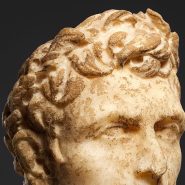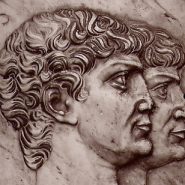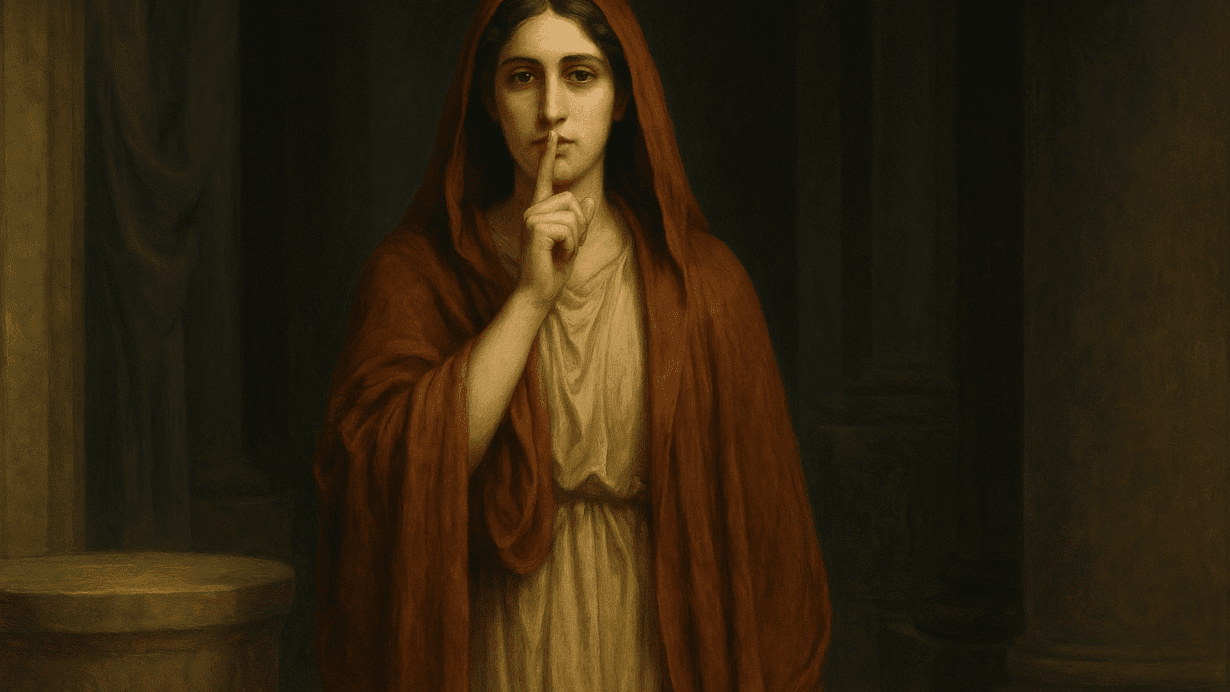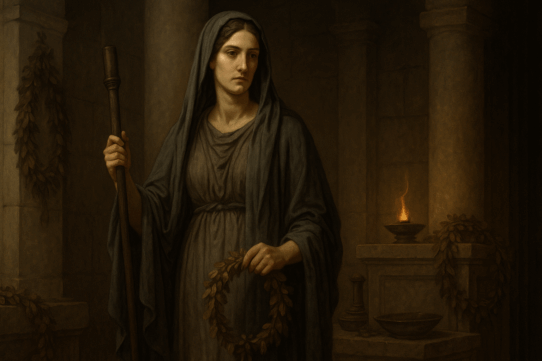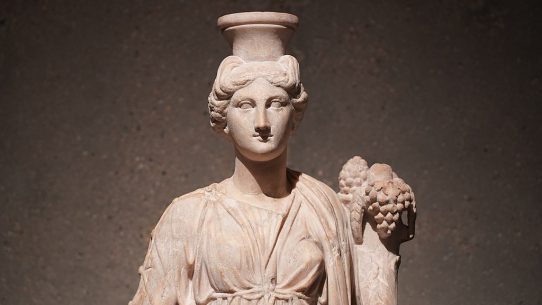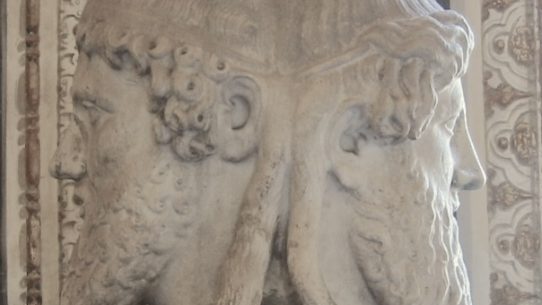QUICK SUMMARY
Angerona is the Roman goddess of silence, secrets, and protection against sorrow. She guards hidden knowledge, comforts the anxious, and preserves the unspoken truths that keep a city or household safe. Her quiet power symbolizes inner strength, calm, and emotional resilience.
Angerona is one of the most enigmatic figures in Roman religion, a goddess wrapped in deliberate quiet and mystery. Unlike the more familiar gods of love, war, and agriculture, she presides over silence, secrets, and the hidden burdens people carry.
Her cult was small yet deeply respected, and her presence signaled the Romans’ recognition that some truths require protection, some emotions deserve privacy, and some forms of healing begin only when the noise of the world fades away.
Although she is not widely known today, Angerona held an honored place in the Roman calendar, invoked at a sacred moment when the year approached its turning point. Her role extended far beyond simple quietness. She guarded the things unspoken, relieved the anxieties that weighed on the heart, and ensured that the city itself maintained its most treasured secret. Through her, the Romans acknowledged that silence can be powerful, protective, and transformative.
Origins and Early Traditions
The origins of Angerona are difficult to trace, partly because her very nature encourages secrecy and restraint. Scholars believe she belongs to an early stratum of Roman religion, one that preceded the highly narrative mythologies of later centuries.
Her name may connect to the Latin word angustia, meaning distress or tightness, a reference to the emotional or spiritual constrictions she was believed to relieve. Others have linked her to angere, meaning to throttle or to strangle, which metaphorically describes the suffocating feeling of anxiety that her presence could dispel.
Her early worship took place in the city itself, centered around seasonal renewal and the quiet invocation of protection. Unlike many deities whose stories unfold in elaborate myths, Angerona’s significance emerges through ritual, symbolism, and the reverent silence that surrounded her cult.
Goddess of Silence and the Unspoken
Silence held deep meaning in Roman culture. It symbolized discipline, reverence, and the ordered functioning of society. Angerona personified the sacred dimension of quiet, serving as the goddess who guarded the things that must remain hidden or protected.
Her imagery often shows her with a finger pressed to her lips, commanding stillness. Some ancient depictions present her wearing a sealed mouth or a band covering her lips, emphasizing her authority over the unspoken. This association was not merely symbolic. Silence was considered essential to certain rituals, political decisions, and religious practices.
To invoke Angerona was to acknowledge that silence preserves safety. Words have consequences. Secrets carry weight. The Romans were acutely aware that discretion often held a community together, and Angerona embodied the power and value of holding one’s tongue.
Protectress of Rome’s Most Sacred Secret
One of the most compelling traditions tied to Angerona is her association with the secret name of Rome. Ancient Romans believed that the city possessed a true name known only to its gods. This name was never spoken aloud, for revealing it could expose Rome to supernatural harm or hostile enchantment.
Angerona served as the guardian of this hidden name. She ensured that the spiritual identity of the city remained protected from enemies, both mortal and divine. In this role, she was not only a goddess of silence but also a defender of Rome’s deepest vulnerability. Her secrecy sustained the city’s stability and symbolized the belief that the most important truths are often the ones that remain unsaid.
Relief from Sorrow and Emotional Pain
While Angerona’s association with silence is well known, she also functioned as a goddess of emotional release and inner healing. Ancient writers suggest she was invoked to ease sorrow, fear, and anxiety. In a world shaped by uncertainty, disease, war, and sudden misfortune, the Romans recognized that emotional suffering required its own kind of divine support.
The connection between silence and healing is not accidental. Angerona’s quiet presence embodied the sanctuary one finds in moments of introspection. When people visited her shrine, they sought relief from the internal pressures that felt too heavy to speak aloud. She represented comfort through stillness, clarity through calm, and strength through restraint.
Her worshipers believed she could loosen the tightness of the soul and bring peace to the troubled heart. This dual identity as a goddess of secrecy and of solace makes her one of the most psychologically resonant figures in Roman mythology.
The Temple of Angerona
Angerona had a temple near the Forum Holitorium, a marketplace where vegetables, flowers, and herbs were sold. Its location hints at a symbolic connection between nourishment and quiet contemplation. Even in the lively environment of Roman commerce, her temple offered a space of stillness.
Little is known about the rituals performed within her sanctuary. This absence of detail aligns with her nature. Her cult did not rely on elaborate ceremonies or public spectacle. Instead, it focused on reflection, protection, and the subtle forms of worship that honored confidentiality and inner quiet.
The very lack of information surrounding her rites speaks to her power. The Romans intentionally preserved the silence that was her domain.
The Divalia: Festival of Angerona
Angerona’s festival, the Divalia, was celebrated on December 21, near the winter solstice. This timing was meaningful. It marked the moment when the longest night began to give way to returning light. In this seasonal turning point, the Romans acknowledged both the hush of winter and the promise of renewal.
During the Divalia, offerings were made to Angerona in her temple. Priests honored her with quiet prayers requesting protection for individuals and for the city as a whole. Although specific ritual details remain elusive, the thematic significance is clear: the festival symbolized the release of fear, the guarding of secrets, and the transition from darkness to a new cycle of light.
Celebrating Angerona at the edge of the year reinforced her role as a goddess who watches over the hidden and guides people through uncertainty.
Symbolism and Interpretation
Angerona’s symbolism is rich and multilayered.
Silence as Strength
Her presence affirms that restraint can be a form of wisdom. Not all truths require immediate expression. Silence can protect, clarify, and heal.
Protection of the Vulnerable
As guardian of Rome’s true name, she represents the safeguarding of what is most precious. She teaches that strength often lies in guarding the things we cherish.
Healing of the Heart
Her connection to relieving sorrow highlights the emotional intelligence present in Roman spirituality. Angerona embodies the belief that internal peace begins in stillness.
Renewal and Inner Light
Her festival at the winter solstice underscores her role in guiding people through the darker parts of life toward emerging clarity.
Legacy and Modern Relevance
In the modern world, Angerona’s themes resonate strongly. Silence can be restorative in an era saturated with noise. Secrets, when ethically held, protect relationships and secure trust. Emotional suffering still requires space, reflection, and quiet support. Angerona’s ancient wisdom remains remarkably relevant.
She symbolizes mindful restraint, emotional balance, and the profound healing found in moments of quiet. Through her, we remember that silence is not emptiness. It is a form of presence, one that holds space for clarity and renewal.
Conclusion
Angerona may not command the elaborate stories of Rome’s more famous deities, but her influence is deeply felt. As the goddess of silence, secrets, and the hidden life of the soul, she stands at the intersection of spirituality and psychology. Her protection sustained Rome’s most sacred identity, while her gentle guidance offered relief from inner suffering.
To honor Angerona is to acknowledge the power of quiet presence. She reminds us that some truths grow stronger when guarded, that some forms of healing begin with silence, and that the deepest wisdom often speaks softly.
